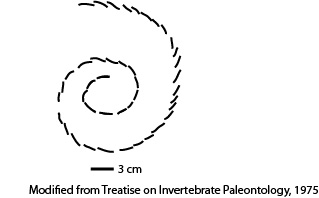Spirodesmos Andree, 1920
DESCRIPTION: One-way irregular spiral burrows, with 1.5 to at most 6 turns with no central turnaround. Circular to elliptical in section, mostly preserved as convex epireliefs, frequently slightly compressed vertically. Traces may have linings 0.4–0.8 mm thick with massive burrow fill. Burrow diameters are quite regular, ranging from .4 to .6 cm. Individual loops are developed close to each other, slightly eccentrically but following and overrunning an earlier loop. Diameter of whorls varies between 1.2 to 8 cm, with a reduction of about 10% recorded in every turn. Most commonly, traces are found frequently overrunning and intersecting each other. Found on bedding surfaces.
BEHAVIOR(S): Locomotion, grazing
ENVIRONMENTAL SETTINGS: Marine turbidites
POSSIBLE TRACEMAKERS: Polychaetes, Holothuroids, small crabs
GEOLOGIC RANGE: Proterozoic-Lower Tertiary
ADDITIONAL REFERENCES: Ekdale and Mason, 1988; Uchman, 1998; Acenolaza, G.F., 2007.
REMARKS: Proterozoic traces are considered to be primitive grazing strategies while later Paleozoic traces are more regular and don’t cross previous whorls. Spirodesmos can be compared to the Vendian ichnotaxon Protospiralichnus.
